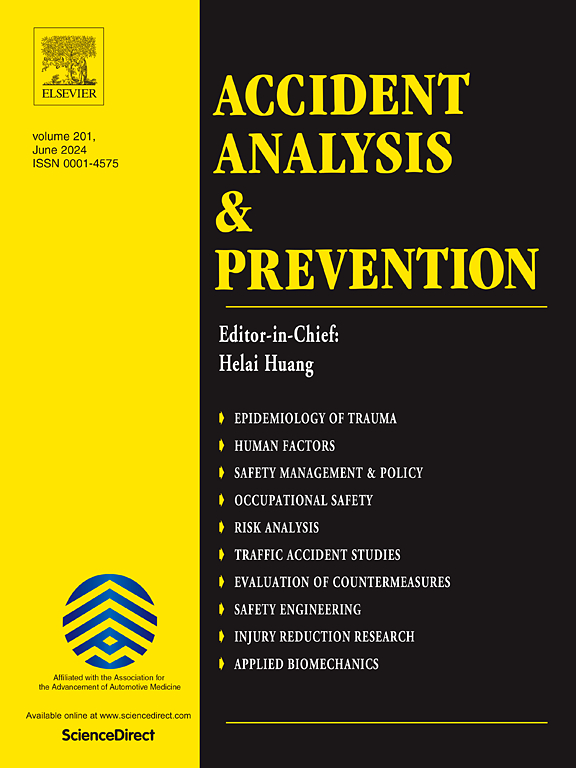Investigating the impact of in-vehicle warning information complexity on drivers: The role of working memory capacity and cognitive load
IF 6.2
1区 工程技术
Q1 ERGONOMICS
引用次数: 0
Abstract
In-vehicle warning systems significantly reduce collisions. However, poorly designed warnings, such as those with excessive or insufficient information, intensify the resource consumption of the drivers. The working memory is a crucial component of the cognitive function, which is closely related to the processing of short-term information. Therefore, this paper investigates the impact of the complexity of the warning messages on the behavior and physiological states of the driver, taking into account individual differences in working memory capacity and cognitive load levels. A total of 37 participants are recruited to conduct a 4 (warning information complexity) × 2 (working memory capacity) × 2 (cognitive load) mixed design driving simulation experiment, with working memory capacity treated as a between-subjects factor. An eye-tracker and a physiometer are employed to record participant’s visual motion and heart rate. A correlation analysis is then conducted to identify key dependent variables, and a Generalized Linear Mixed-effects Model (GLMM), which considers random effects, is used to analyze the impact of each experimental factor on the drivers. The obtained results demonstrate that visually rich warnings lead to increased braking reaction times, especially between drivers having low working memory capacity and under high cognitive load. Although detailed warnings are easier to understand, they tend to reduce Root Mean Square of Successive Differences (RMSSD) of the driver under higher cognitive loads, indicating increased tension and annoyance. In addition, the combination of visually simple and auditorily rich warnings has significant advantages, allowing almost all types of participants to perceive risks more quickly, which significantly reduces the collision risks. These findings offer theoretical insights to assist manufacturers in designing human-centered, personalized, and adaptive in-vehicle warning systems.
车内警示信息复杂性对驾驶员的影响:工作记忆容量和认知负荷的作用
车载警告系统显著减少碰撞。然而,设计不良的警告,例如那些信息过多或不足的警告,加剧了司机的资源消耗。工作记忆是认知功能的重要组成部分,它与短期信息的加工密切相关。因此,考虑到工作记忆容量和认知负荷水平的个体差异,本文研究了警告信息的复杂性对驾驶员行为和生理状态的影响。招募37名被试进行4(预警信息复杂性)× 2(工作记忆容量)× 2(认知负荷)混合设计驾驶模拟实验,工作记忆容量作为被试间因素。使用眼动仪和生理测量仪记录参与者的视觉运动和心率。然后进行相关分析以确定关键因变量,并使用考虑随机效应的广义线性混合效应模型(GLMM)来分析每个实验因素对驾驶员的影响。结果表明,视觉效果丰富的警告会导致制动反应时间的增加,特别是在工作记忆容量低和认知负荷高的驾驶员之间。虽然详细的警告更容易理解,但它们往往会降低驾驶员在高认知负荷下的连续差异均方根(RMSSD),表明紧张和烦恼的增加。此外,视觉简单和听觉丰富的预警相结合具有显著的优势,几乎所有类型的参与者都能更快地感知风险,从而显著降低碰撞风险。这些发现为帮助制造商设计以人为本、个性化和自适应的车载预警系统提供了理论见解。
本文章由计算机程序翻译,如有差异,请以英文原文为准。
求助全文
约1分钟内获得全文
求助全文
来源期刊

Accident; analysis and prevention
Multiple-
CiteScore
11.90
自引率
16.90%
发文量
264
审稿时长
48 days
期刊介绍:
Accident Analysis & Prevention provides wide coverage of the general areas relating to accidental injury and damage, including the pre-injury and immediate post-injury phases. Published papers deal with medical, legal, economic, educational, behavioral, theoretical or empirical aspects of transportation accidents, as well as with accidents at other sites. Selected topics within the scope of the Journal may include: studies of human, environmental and vehicular factors influencing the occurrence, type and severity of accidents and injury; the design, implementation and evaluation of countermeasures; biomechanics of impact and human tolerance limits to injury; modelling and statistical analysis of accident data; policy, planning and decision-making in safety.
 求助内容:
求助内容: 应助结果提醒方式:
应助结果提醒方式:


